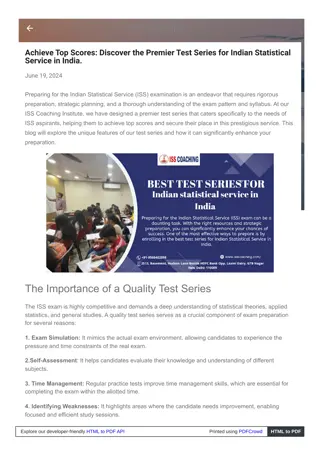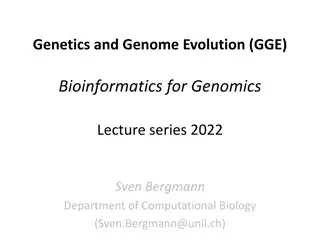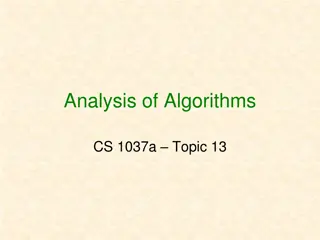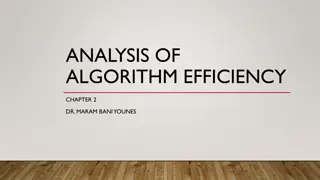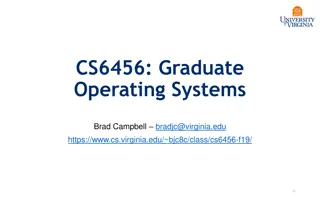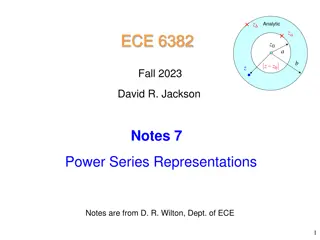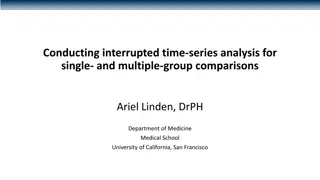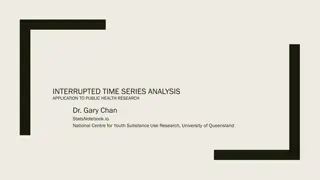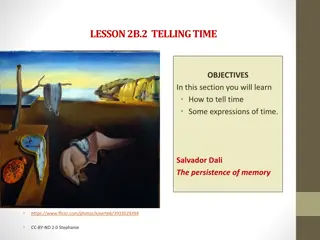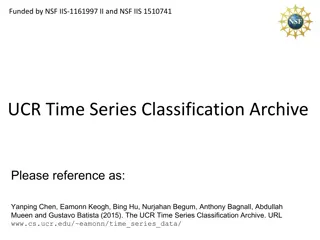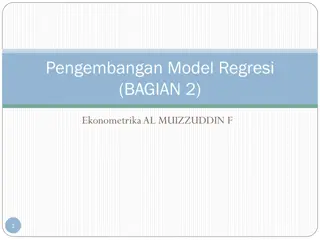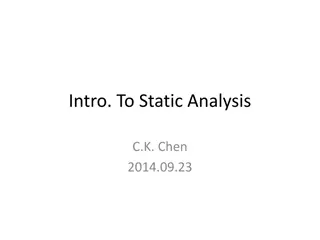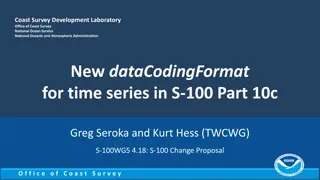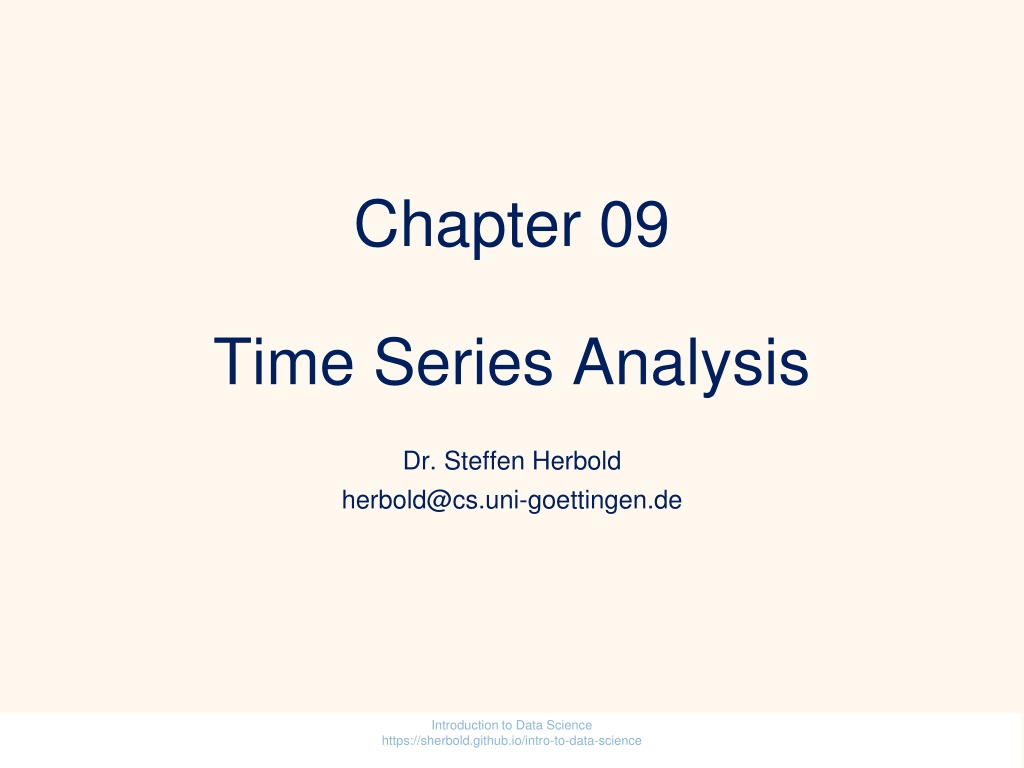
Time Series Analysis Overview
"Explore the methods and examples of time series analysis, including Box-Jenkins approach, trends, seasonal effects, and autocorrelation in data science. Understand the formal and general problems related to analyzing data over time for valuable insights."
Download Presentation

Please find below an Image/Link to download the presentation.
The content on the website is provided AS IS for your information and personal use only. It may not be sold, licensed, or shared on other websites without obtaining consent from the author. If you encounter any issues during the download, it is possible that the publisher has removed the file from their server.
You are allowed to download the files provided on this website for personal or commercial use, subject to the condition that they are used lawfully. All files are the property of their respective owners.
The content on the website is provided AS IS for your information and personal use only. It may not be sold, licensed, or shared on other websites without obtaining consent from the author.
E N D
Presentation Transcript
Chapter 09 Time Series Analysis Dr. Steffen Herbold herbold@cs.uni-goettingen.de Introduction to Data Science https://sherbold.github.io/intro-to-data-science
Outline Overview Methods for Time Series Analysis Summary Introduction to Data Science https://sherbold.github.io/intro-to-data-science
Example of Time Series Analysis 420 in January 431 in February Our sales in the next two months will be 415 in March Time Series Analysis Data over time Sales Passengers Traffic 509 in July Introduction to Data Science https://sherbold.github.io/intro-to-data-science
The General Problem Data over time Value at time point 1 Value at time point 2 Value at time point 3 Value at time point 4 Value at time point 5 Value at time point 6 Value at time point 7 Value at time point 8 Value at time point 9 Time Series Analysis Introduction to Data Science https://sherbold.github.io/intro-to-data-science
The Formal Problem Discrete values over time {?1, ,??} = {??}?=1 Can be seen as a series of random variables or a stochastic process Time between ? and ? + 1 must be equal for all ? = 1, ,? 1 Minutes, hours, days, weeks, months, with ?? ? Components of a time series General trend of the time series ?? Seasonal effects on the time series ?? Autocorrelation between observations ?? ??= ??+ ??+ ?? Introduction to Data Science https://sherbold.github.io/intro-to-data-science
Outline Overview Methods for Time Series Analysis Summary Introduction to Data Science https://sherbold.github.io/intro-to-data-science
Time Series Analysis with Box-Jenkins For stationary data Stationary means constant mean value and variance Requires de-trending and seasonal adjustment Models autocorrelation as a stochastic process Observations depend on past observation and a random component Tries to model time series with only few parameters Goal are simple models Introduction to Data Science https://sherbold.github.io/intro-to-data-science
Detrending Through Regression Detrended series ?? ?? Regression of the trend ?? Non-linear regression for non-linear trends Introduction to Data Science https://sherbold.github.io/intro-to-data-science
Seasonal Adjustment through the Mean Seasonal effect: A regularly repeating pattern Monthly, weekly, Seasonal adjustment through the seasonal mean value Introduction to Data Science https://sherbold.github.io/intro-to-data-science
Differencing for Detrending Instead of regression / removal of mean seasonal effects Differencing for detrending of order ? First difference for moving mean values (? = 1) Similar to linear trends 1??= ?? ?? 1 Second difference for moving mean and the change in the movement (? =2) Similar to quadratic trends 2??= 1?? 1?? 1= ?? 2?? 1+ ?? 2 Introduction to Data Science https://sherbold.github.io/intro-to-data-science
Differencing for Seasonal Adjustment Seasonal differencing for seasons of periodicity ? ???= ?? ?? ? 12??= ?? ?? 12would be seasonal differencing for monthly data Introduction to Data Science https://sherbold.github.io/intro-to-data-science
Comparison of Adjustments Introduction to Data Science https://sherbold.github.io/intro-to-data-science
Autocorrelation Relationship between time series values with other time series values Fairly linear relationship Spread increasing More or less random Introduction to Data Science https://sherbold.github.io/intro-to-data-science
Autocorrelation over Time Strong correlation at ? + 1 Some seasonal effect remaining, weakening every year Weak correlation at ? + 3 Introduction to Data Science https://sherbold.github.io/intro-to-data-science
Partial Autocorrelation Autocorrelation that is not explained by carrying over ?? and ??+1 are correlated ??+1 and ??+2 are correlated How much of the correlation between ??and ??+2is not explained by the above correlations? In other words, how much of the correlation between ??and ??+2is independent of the correlation between ?? / ??+1and ??+1 / ??+2? Correlation at ? + 2 explained by auto correlation at ? + 1 Introduction to Data Science https://sherbold.github.io/intro-to-data-science
ARMA Time Series Models Requires detrended and seasonally adjusted data Model for the autocorrelation part ?? of a time series ??is a random variable with an expected value of 0 white noise ? ? ??= ?0+ ?=1 ???? ?+ ??+ ?=1 ???? ? Autoregressive (AR) Moving Average (MA) Constant plus linear combination of the ? past values Noise term + linear combination of last ? noise values Introduction to Data Science https://sherbold.github.io/intro-to-data-science
Picking ? and ? Analyze (partial) autocorrelation function ? = 1 would model everything except the missing seasonal effect ? = 13 would capture missing seasonal effect at the cost of a more complex model ? = 0 or ? = 1 to account for low random fluctuations Introduction to Data Science https://sherbold.github.io/intro-to-data-science
Outline Overview Methods for Time Series Analysis Summary Introduction to Data Science https://sherbold.github.io/intro-to-data-science
Summary Time series analysis considers data over time Equal intervals More than just regression Seasonal effects Autocorrelation Complex topic with many options for modelling Trend detection Seasonal adjustment Autocorrelation modelling Completely different approaches, e.g., based on neural networks Introduction to Data Science https://sherbold.github.io/intro-to-data-science




